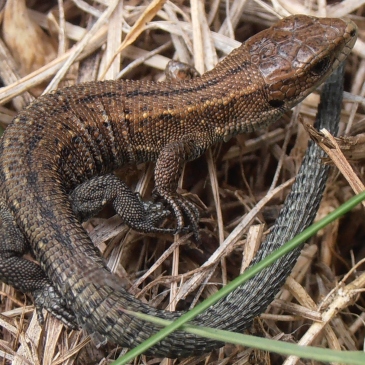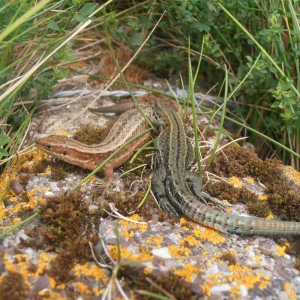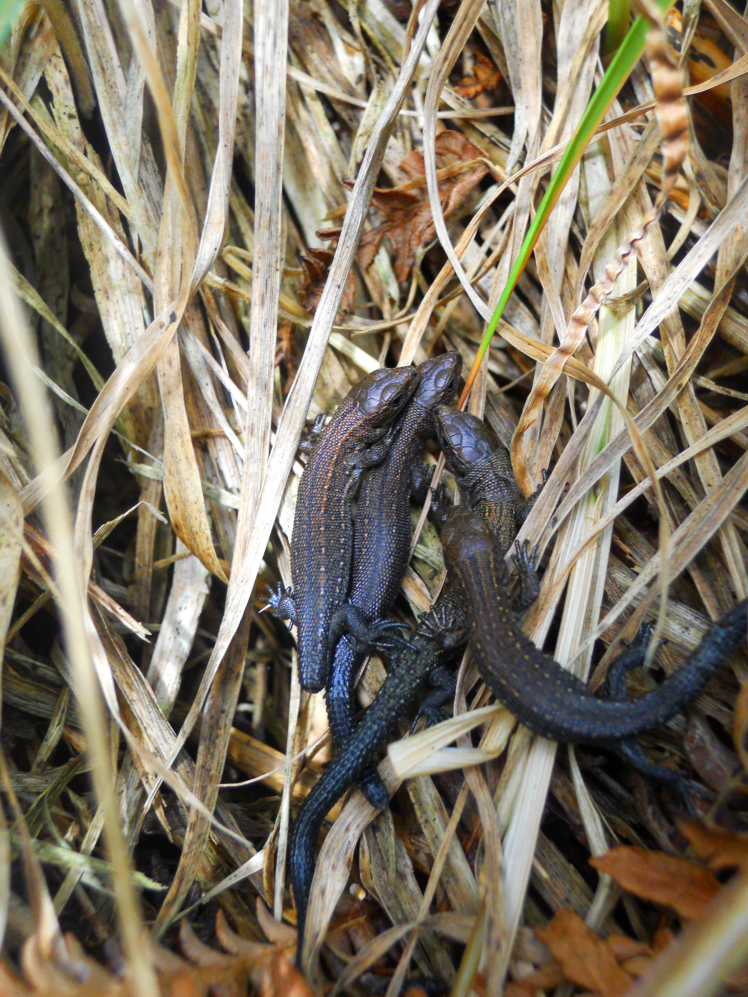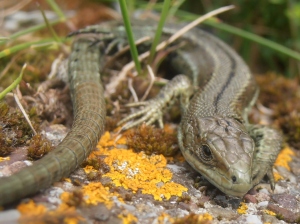
The common lizard (Zootoca vivipara), is Ireland’s only native terrestrial reptile. It is the only species of the genus Zootoca (from the Greek “to give birth”), after being removed from the genus Lacerta in 1996. Zootoca vivipara has the largest distribution of any terrestrial reptile. It is found in much of the northern Palaearctic, from Ireland and the Iberian Peninsula in the west, through the entire Eurasian landmass to Sakhalin Island (Russia) and Hokkaido Island (Japan) in the east. It is established well beyond the Arctic Circle (70°N), and has been found at heights of 3,000m above sea level in Bulgaria. It achieves this by being able to tolerate sub-zero temperatures in a supercooled state at -3°C for at least three weeks and half of its body water as ice for twenty-four consecutive hours. The species is widely distributed on the Irish mainland and at least some of the islands.
Unlike the vast majority of reptiles, it has been found that the common lizard often frequents damp habitats, as the humidity has a beneficial effect on growth rate and activity. Ideal habitats for the species are south-facing, damp tussocky grassland, scrub covered hillsides, dunes or banks, and woodland tracks, and it also resides in peat bogs, dry grasslands and heathlands. The species is tolerant, to a degree, of habitat disturbance (it may even use artificial habitats, e.g. railway embankments, hedgerows, and gardens), and it seems to be relatively tolerant of human presence in rural Ireland.
As reptiles are cold blooded (ectotherms), they rely on environmental heat sources to regulate their body temperature. The species is both heliothermic and thigmothermic; deriving its body heat from both the sun and contact with warm surfaces, respectively. As common lizards are diurnal, they bask in sunlight to raise their body temperature and will retreat to cover when they need to cool down. Sandy/rocky places with a quick escape route are preferred basking spots, where the individual flattens its body whilst basking to absorb heat over greatest surface area possible. A common lizard’s body temperature will drop overnight (when it hides in burrows/crevices) and it will need to bask in a warm, sun exposed spot the following day to bring it back up. As such, early morning can be a particularly good time to spot this fascinating creature. Activities (such as feeding and basking) of Z. vivipara are largely influenced by weather conditions, including solar radiation and cloud cover. Also, it was found that the temperature of air and soil, humidity and wind all influence the seasonal and daily activity patterns of lacertid lizards. While common lizards in warmer parts of Europe are active year round, more Northerly populations (such as the Irish population) will need to brumate (undergo a type of dormancy similar to hibernation) within hibernacula during the colder months. Though there is little known about the hibernacula of common lizards, they are thought to be frost-free refugia below ground or beneath rocks/woodpiles, but this shelter must facilitate thermoregulation

After emerging from brumation in March, male lizards will establish a territory and defend it from rival males. After sloughing their skin, males will mate with an attendant female several times (this generally takes place in May). The mating process itself can appear quite rough, with the male biting the nape of the female to restrain her. After a gestation period of about three months,during which the female increases her time spent basking, she will give birth to between 3 and 12 live young (neonates). This “live birth” is actually where the lizards name derives from; “vivipara” meaning live birth. The name is somewhat misleading though, as these lizards do not give birth to live young in the same way us placental mammals do. Instead, they simply retain the eggs within the oviducts until they hatch, an adaptation that is thought to protect the eggs from colder temperatures in the Northern extremes of its range. This theory appears to be valid, as the species has been known to lay eggs in Southern Europe (i.e. the Cantabrian Mountains, Basque country, Pyrenees and Aquitaine). Both populations are closely related; however, the common lizard has a number of different lineages, some of which may be separate species, which may not be expected given its large geographical range. In viviparous populations, females lay an average of five shell-less eggs, into a soil cavity, from which dark, independent neonates emerge within one hour. The young lizards are self reliant from birth, receiving no parental care whatsoever.
Adult common lizards are an overall brown or green colour; males are usually longer and have shorter heads than the females. The species has short legs, with five digits on each foot. They have complex patterns, and dark spots (ocelli) are more pronounced in males, whereas vertebral stripes are generally more pronounced in females, and males have colourful patterned undersides whereas females have relatively pale unpatterned undersides. It was been found that dorsally reticulated individuals are more adapted to warm climates than linear-patterned individuals. The mean snout-to-vent length of adults is 60mm (for a maximum total length of 170mm, including the tail), and the dark juveniles have a mean snout-to-vent length of 20mm. An adult common lizard is approximately five grams in weight. Male lizards will reach maturity earlier than females (at around 2 and 3 years respectively), as females need to gain more mass to facilitate egg production. The species has a lifespan of approximately five years.

The common lizard feeds on small invertebrates such as gastropods (slugs/snails), arachnids (spiders), annelids (worms) and insects. Once a lizard has grabbed a prey item, it will often shake its head violently to stun the prey item before swallowing it whole, or with the wings removed. It may also enter water bodies to hunt, foraging by sight, as well as utilising its acute sense of hearing.
Of course, the lizard itself can fall prey to larger animals such as kestrels, merlins, corvids, pheasants, blackbirds, shrews, stoats, weasels, hedgehogs and cats. When threatened, a lizard’s first instinct will be to make a dash for cover. This species is quite fast, especially when its body temperature has risen, and running is often an effective defence. However this is not always sufficient, and common lizards can engage in another anti-predatory tactic known as caudal autotomy. Caudal autotomy is the process whereby a lizard sheds its own tail to confuse a predator. If the predator falls for this trick, and attacks the detached tail rather than the lizard, the lizard may escape and can regenerate its tail in time.

Many thanks to Naomi O’ Reilly, with whom we consulted.

One thought on “Common Lizard”
Comments are closed.